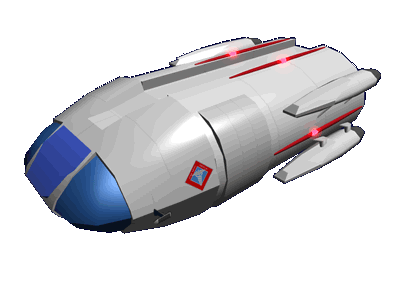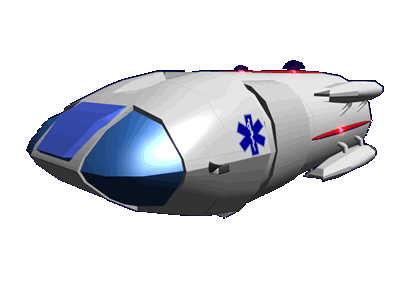Table of Contents
Kuma T8 Medevac Shuttle
The medevac version of the Ke-T8 "Kuma" Multi-role Shuttle became available in YE 32.
About the Medevac Shuttle
The T8-1d version of the Kuma was developed for use by the Star Army Emergency Services medevac Services. A second version, the T8-1e, was made available to Civilian organizations.
History
In the second year of the Second Mishhuvurthyar War a way to rapidly move injured soldiers to medical facilities both on planet and in space was needed. The medevac Version serves as a space capable ambulance.
Appearance
The medevac model has the same tapered body design as the original. Except that neither model has has an aether beam cannon, and both have a series of red strobing light bars added. For Star Army of Yamatai owned T8-1d the Star Army Medical logo is present on both sides of the front of the shuttle. Civilian owned T8-1e's have their owning organization logo.
Statistics and Performance
General
- Class: Ke-T8-1d/1e
- Type: Shuttle
- Designers: Ketsurui Fleet Yards
- Production: Mass Production
Dimensions
Length: 6 meters (19.68 feet) Height: 2 meters (6.56 feet) Width: 3 meters (9.84 feet) (Fuselage) Width: 3.5 meters (11.48 feet) (Overall)
Speeds
The Kuma T8 is an nimble craft.
- Atmospheric: Cruise: 2,143 kmph (1,332 mph) Maximum: 6,125 kmph (3,806 mph)
- Sublight Engines: .375c (~112,422 kilometers per second) (~69,856 miles per second)
Passengers
Crew: 2 operators are recommended, but only one is required. Passengers: 6 Maximum Capacity: There are accommodations for 8 people (2 crew, 6 passengers)
Variant Differences
The Kuma is available in three different models. The information below identifies the differences.
Ke-T8-1d - Yamatai Services
Manufactured by: Ketsurui Fleet Yards, Scientific Studies Service Used by: Star Army of Yamatai
- SPINE interface in pilot seat
- Yamataium hull with Durandium Alloy frame
Ke-T8-1e - Civilian
Manufactured by: Geshrinari Shipyards (Under a special license with Ketsurui Fleet Yards)
- Durandium Alloy hull with Durandium Alloy frame
Damage Capacity
See Damage Rating (Version 3) for an explanation of the damage system.
T8-1d
- Hull: Tier 8 (Medium Mecha)
- Shields: Tier 8 (Barrier)
T8-1e
- Hull: Tier 7 (Light Mecha)
- Shields: Tier 7 (Barrier)
Inside the Shuttle
The Interior is identical to the Ke-T8 "Kuma" Multi-role Shuttle, except for the addition of four mounting points for up to four Ke-T8-M3202 Docking Stations.
- 1 - 4 Ke-T8-M3201 Grav Gurneys
Typically only 1 or 2 Ke-T8-M3201 Grav Gurney are installed, unless the shuttle is being used to transport multiple patients from one medical facility to another. In cases where the patients are ambulatory, the shuttle will use the passenger seats for such transfers.
Overhead lockers
The six overhead lockers in the passenger area are for storing medical equipment and supplies. By mounting them high leaves all of the passenger floor space free. Typical equipment includes:

